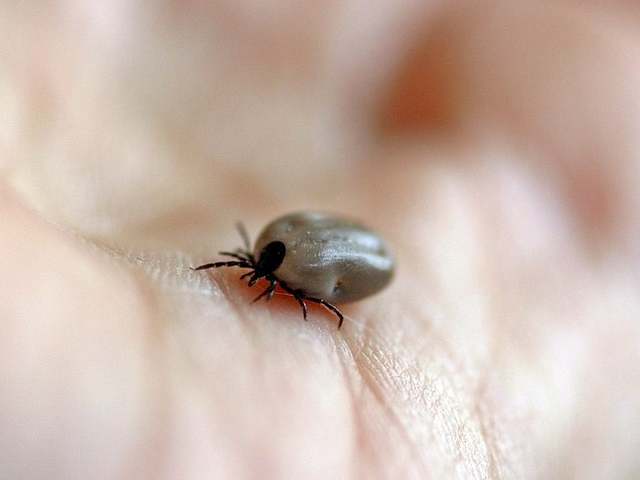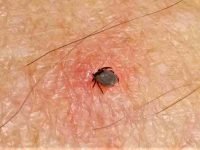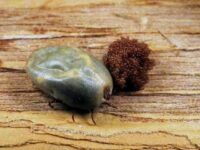In comparison to a mosquito bite or a bee sting, in which the actual biting or stinging of the insects is quickly over, a tick bite takes much longer. And unlike a bee or wasp sting, which is immediately noticeable and can usually be very painful, the tick bite is painless and is hardly noticed. The tick releases an anesthetic into the bite site, and only when the anesthetic wears off will you feel an itch or a burning sensation. But how long does a tick bite last?
To answer how long a tick bite lasts, we have to differentiate between:
- the actual tick bite – from the moment the tick bites and starts it blood meal until it falls off by itself
- the possible long-term ill effects of the tick bite – like allergic reactions, infection of the wound and transmitted diseases
How long does a tick bite last?
If the tick has managed to transfer to a host it begins to search for a suitable bite site. It needs to find bare skin, that can be on arms, the face and upper body or the legs. Ticks prefer places where the skin is thin and soft. When a suitable bite site is found then the actual bite begins. How long does the tick bite last until it falls off?
If you are bitten and do not notice, the tick will stay with its feeding apparatus buried into your skin until it is full of blood and then fall off. How long the feeding act takes depends on the development stage of the tick and the species of the tick, it can be roughly a couple of days, of up to 10 days.
- Tick Larve – 2 to 4 days
- Tick Nymph – 3 to 5 days
- Adult Tick – 6 to 8 days
In the beginning, a tick is tiny – not even a millimeter, so it is easy to overlook. After a while, the body of the tick increases dramatically in volume and size. The gain in weight during the feeding process can be as much as 200 to 300 times.
A tick bite can be dangerous
The actual injury that is inflicted by the tick is often harmless. After all, it is only a tiny stab wound, which will heal up in a couple of days without any problems. However, in some cases, problems develop due to allergic reactions, wound infections or even transmission of dangerous diseases.
Complications after a Tick Bite
Allergic Reaction
In some hosts – humans, as well as pet dogs or cats – complications may include a tick bite allergy as a result of the body’s reaction to proteins contained in the saliva of the tick.
The severe course of tick bite allergy can lead to the classic symptoms of an allergic reaction: fatigue, nausea, vomiting, diarrhea, skin reactions, difficulty breathing, fainting, or anaphylactic shock.
In rare cases, the body reacts to a toxin in the tick’s saliva, which can lead to a “tick paralysis“. Symptoms may include weakness, numbness, and paralysis beginning in the extremities and the lower body, extending to the respiratory system or the heart muscle, resulting in death. If a tick bite allergy is suspected, you should immediately see a medical doctor!
Wound Infection
After a tick bite, a local reddening around the wound is usually observed. This is in most cases just a reaction of the body to the injury. Local wound infection is possible if parts of the tick remain or if pathogens through scratching or bad wound hygiene are introduced. This should heal up within a couple of days.
Tick-Transmitted Diseases
After removing a tick, you should carefully watch the puncture site.
If, after a few days to weeks, a ring-shaped reddening of the skin, appears a doctor should be consulted for further clarification.
If you develop flu-like symptoms such as fever, fatigue, headache or body aches a couple of days following a tick bite, consult a doctor.
Ticks can transmit a number of infectious diseases to humans. One of the most important common tick-borne diseases is Lyme disease (aka Borreliosis), a bacterial infection caused by bacteria.
Other diseases transmitted by ticks to humans include human anaplasmosis, babesiosis colorado tick fever, ehrlichiosis, rocky mountain spotted fever and a few other bad illnesses.
Preventing tick bite
The best and most natural protection against ticks is wearing long clothing as well as sturdy shoes. This makes it more difficult for ticks to reach the body and find a suitable bite site.
After being outdoors in tick-prone areas you should search for ticks that crawl around on clothing. Wearing light-colored clothing makes it easier to find ticks. In particular, children should be thoroughly examined after playing outdoors.
When the tick has made it under your clothing it will search for a soft skin area to bite.
Ticks prefer places such:
- hairline, neck
- behind the ears
- kneepit, armpit
- navel
- groin area
- between the fingers or toes
Despite all precautions, a tick bite may not always be avoided. When bitten it will take up to 10 days until the tick is full of blood and falls off.
If you spot a tick, remove it with special tweezers or other suitable utensils. The longer the bite takes, the greater the risk of complications and illness. It is advisable to consult a doctor.
Summary
Ticks are found almost everywhere in the world. Only the coldest places on the planet have not been invaded by ticks yet. But the climate is changing and ticks spread. In the moderate climate zones, ticks are already active throughout the year and in the tropics anyway. Ticks can be found in cities, in parks, in forests, meadows, and gardens, even on our balconies and terraces.
It is not easy to protect yourself from a tick bite. The best is wearing long, tight-fitting clothing that leaves little skin exposed. In addition to tick protection through special clothing, it is also recommended to use good tick repellents.



